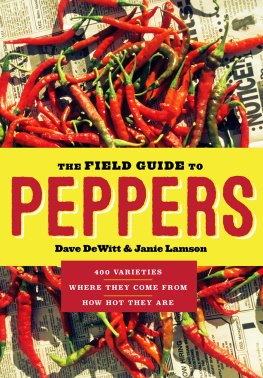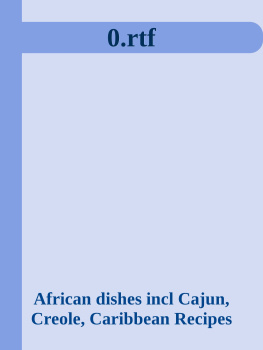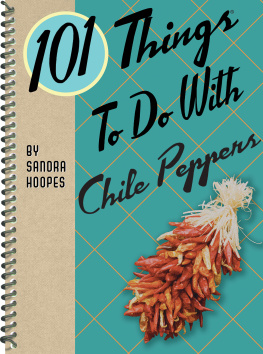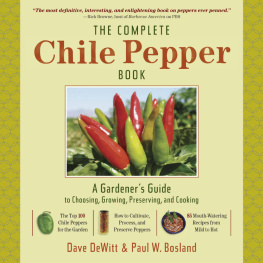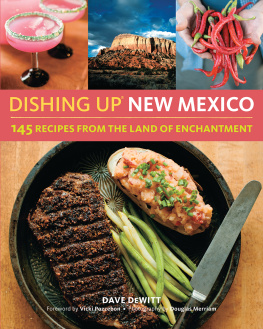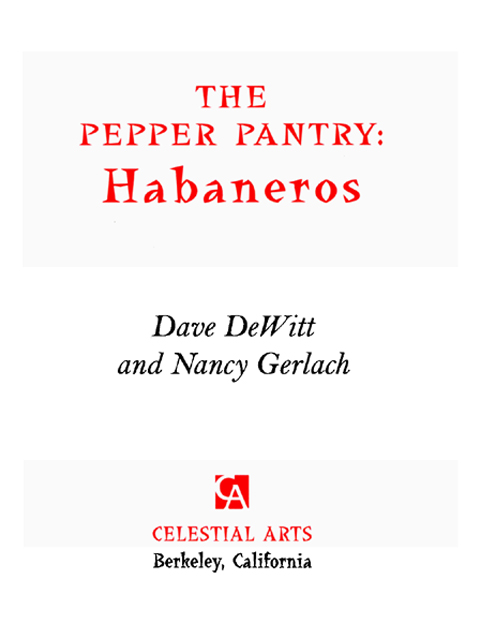Copyright 1997 by Dave DeWitt and Nancy Gerlach
All rights reserved. No part of this book may be reproduced in any form, except brief excerpts for the purpose of review, without written permission from the publisher.

Celestial Arts
an imprint of Ten Speed Press
Post Office Box 7123
Berkeley, California 94707
www.tenspeed.com
Distributed in Australia by Simon & Schuster Australia, in Canada by Ten Speed Press Canada, in New Zealand by Southern Publishers Group, in South Africa by Real books, and in the United Kingdom and Europe by Publishers Group UK.
Design by Toni Tajima
Library of Congress Cataloging-in-Publication Data:
DeWitt, Dave
The pepper pantry. Habaneros / by Dave DeWitt and Nancy Gerlach1st ed.
p. cm.
eISBN: 978-0-307-82043-3
1. Cookery (Hot peppers) 2. Hot peppers. I. Gerlach, Nancy.
II. Title
TX803.P4-6D487 1997
641.6384dc20
96-31709
v3.1
CONTENTS
THE HOTTEST OF THE HOT
T he previously obscure habanero has become the designer chile of choice in the United States in about a decade. We can take some minor credit for this, as we were instrumental in giving the habanero early publicity. But rave reviews alone are not enough to account for the continuing explosion of habanero products, habanero gardening, and habanero recipes.
We believe the popularity of habs is a combination of three factors. Of course, their extreme heat is what the legend is all about, though nonpungent habaneros do exist. But beyond the heatwhich can easily be tempered by other ingredientsare two other olfactory considerations: aroma and f1avor. The unmistakable aroma of the habanero persists through cooking and processing and is often referred to as apricot-like. It is not only the hottest of the hot, but perhaps the most flavorful.
Whats in a name? Origins
Habaneros and their kin are varieties of Capsicum chinense, which is one of the five domesticated species of peppers. As is true with the rest of the peppers, the nomenclature of the chinense species is highly confusing. There are three major difficulties: a misnamed species, the misuse of the word habanero, and a confusing number of common names.
The species was misnamed Capsicum chinense in 1776 by Nikolaus von Jacquin, a Dutch physician who collected plants from 1754 to 1759 in the Caribbean for Emperor Francis I. Jacquin wrote, mysteriously, I have taken the plants name from its homeland, which was dead wrong. We are now stuck with a totally inaccurate species name of a supposedly Chinese pepper thats not from China but the Caribbean and South America.
The second nomenclature problem is with the word habanero (sometimes erroneously spelled habaero), when it is used in English to represent the entire chinense species. That appelation is a misnomer because there are dozensif not hundredsof pod types within the species, and the Spanish name habanero technically refers to a specific pod type from the Yucatn Peninsula. But because consumers in the United States were familiar with the Mexican peppers, habanero became the buzz word for the specieseven to the point where writers were calling the Scotch bonnet a type of habanero. Wrong. The Scotch bonnet and habanero are different pod types of the same species. Despite all this logic, we admit that the word habanero has come into common usage as the generic term for the speciesand that is why we use it in that manner in the title of this book. The third nomenclature problem is the plethora of common names ranging from Scotch bonnet to bonney pepper to bonda man Jacques to Congo pepper.
But what about the Cuban connection? Isnt that the origin of the word habanero, meaning from Havana? Pepper experts have long debated the possible Cuban origin for the habaneros that are grown today in the Yucatn Peninsula of Mexico and Belize. Mexican horticulturists Cancino Laborde and P. Pozo Compodonico stated that the habanero is the only pepper in Yucatn without a Mayan name, which would indicate that it was imported. We have grown seeds from Cuban immigrants that turned into the familiar orange habaneros, another indication of their Cuban origin.
The Amazon basin was the center of origin for the chinense species, but the story of the spread of the wild varieties and their eventual domestication is still not clear. However, the oldest known chinense specimen ever found was a single intact pod (probably a wild form) that was discovered in Preceramic levels (6,500 B.C.) in the Guitarrero Cave of coastal Peru.
Since both wild and domesticated forms of the Brazilian chinense exist today, it follows that the species was domesticated in much the same manner as the annuum species in Mexico: first, it was a tolerated weed with erect fruits. Then, as early farmers planted the seeds and tended the plants, there was a gradual evolution by human selection to larger, more pendant pods.
The domestication of the chinense species occurred around 2000 B.C., and, according to ethnobotanist Barbara Pickersgill, it was probably connected with the development of agriculture in tropical forests. It seems reasonable to assume that C. chinense was domesticated east of the Andes by tropical forest agriculturists, who were probably responsible for the domestication of manioc. She added, wryly, As a condiment, the chile pepper probably formed a welcome addition to any diet consisting largely of manioc starch. By about 1000 B.C. , domesticated chinense varieties had spread to the Pacific coast of Peru.
The cultivation of the chinense species produced many pod types and varieties. Bernabe Cobo, a naturalist who traveled throughout South America during the early seventeenth century, was probably the first European to study the chinense species. He estimated that there were at least forty different pod types, some as large as limes or large plums; others, as small as pine nuts or even grains of wheat, and between the two extremes are many different sizes. No less variety is found in color and the same difference is found in form and shape.
Chinense was and is the most important of the cultivated pepper species east of the Andes in South America. Barbara Pickersgill notes that the fruity characteristics of the species are more variable around the mouth of the Amazon than further west because of human selection of the pods.
The dispersion of domesticated chinense types into the Caribbean and Central America occurred in two different directions. Some chinense varieties spread into the isthmus from Colombia and eventually became common in Panama and Costa Rica. But apparently their spread north was halted before they reached the Yucatn Peninsula.
Meanwhile, the ancestors of the Arawaks and Caribs, transferred the chinense from the Amazon Basin through Venezuela and into the Caribbean, where pod types developed on nearly every island.
A hot history
When Columbus first explored the Caribbean islands in 1492, theres a good chance that the first chile pepper he encountered was a Scotch bonnet or its cousin. So it would not be surprising if Columbus misnamed the pod


